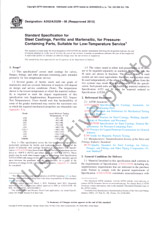We need your consent to use the individual data so that you can see information about your interests, among other things. Click "OK" to give your consent.
ASTM E3152-18
Standard Guide for Standard Test Methods and Practices Available for Determining Antifungal Activity on Natural or Synthetic Substrates Treated with Antimicrobial Agents
Translate name
STANDARD published on 1.2.2018
The information about the standard:
Designation standards: ASTM E3152-18
Note: WITHDRAWN
Publication date standards: 1.2.2018
SKU: NS-811006
The number of pages: 11
Approximate weight : 33 g (0.07 lbs)
Country: American technical standard
Category: Technical standards ASTM
The category - similar standards:
Annotation of standard text ASTM E3152-18 :
Keywords:
antifungal activity, antifungal agent, antifungal tests, mildewcides, mold test,, ICS Number Code 11.100.20 (Biological evaluation of medical devices)
Additional information
| Significance and Use |
|
3.1 Fungi are known to produce objectionable odors, stains, and premature biodeterioration of various consumer products and construction substrates including textiles, carpet, ceiling tile, gypsum wallboard, lumber, and plasticized vinyl and other polymers. 3.2 Antifungal activity is typically: 3.2.1 Determination of article susceptibility to fungal colonization, 3.2.2 Determination of fungistatic activity (qualitative determination of prevented or delayed fungal colonization), and 3.2.3 Determination of fungicidal/sporicidal activity (quantitative determination of spore kill). 3.3 The degree of required surface examination varies from gross visual examination to detailed microscopic assessment among these methods. 3.4 This guide provides an overview of established methods and suggestions for their applicability, with consideration to the type of substrate treated or the type of antifungal treatment being assessed. |
| 1. Scope |
|
1.1 This guide provides information on various test methods currently available to assess antifungal activity on natural or synthetic substrates. 1.2 Knowledge of microbiological techniques is required for the practice of this guide. 1.3 This standard does not purport to address all of the safety concerns, if any, associated with its use. It is the responsibility of the user of this standard to establish appropriate safety, health, and environmental practices and determine the applicability of regulatory limitations prior to use. 1.4 This international standard was developed in accordance with internationally recognized principles on standardization established in the Decision on Principles for the Development of International Standards, Guides and Recommendations issued by the World Trade Organization Technical Barriers to Trade (TBT) Committee. |
We recommend:
Technical standards updating
Do you want to make sure you use only the valid technical standards?
We can offer you a solution which will provide you a monthly overview concerning the updating of standards which you use.
Would you like to know more? Look at this page.




 Cookies
Cookies
